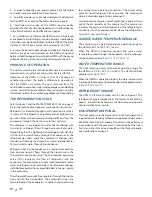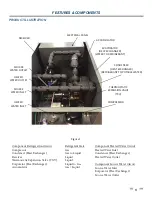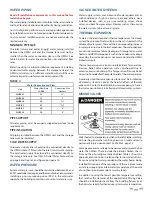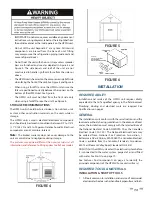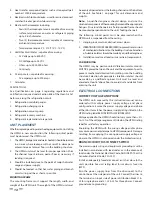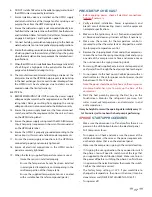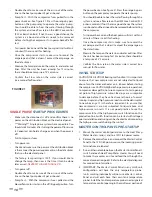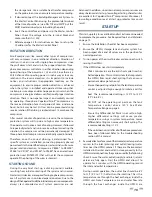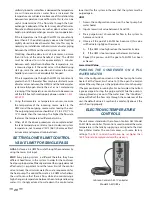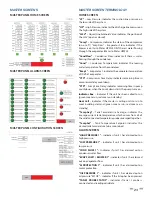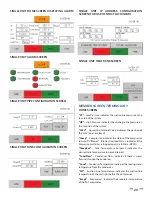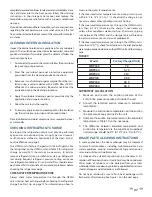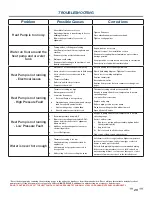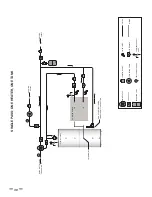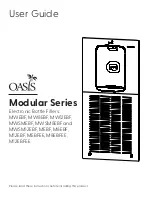
15
TRANSFORMER CONFIGURATION 208 VAC MODELS
WHP025 & WHP060 Only
The transformer leads must be changed on units connected
to a 208 VAC power supply as described below.
Turn on power to the HPWH momentarily and measure the
voltage to the primary winding of the transformer at the
F3 fuse block. If the measured voltage is above 215 VAC no
changes are necessary.
If the measured voltage is 215 VAC or less, then the primary
leads of the transformer must be changed from the 230 VAC
tap to the 208 VAC tap. Do this by disconnecting the orange
wire from the transformer primary terminal and replacing
with the red wire. Before reapplying power, ensure orange
lead is safely isolated with a wire nut and electrical tape.
WATER CONNECTIONS
Water piping must be installed in accordance with the instructions
in this manual and all local plumbing codes having jurisdiction.
See Figure 7 and Figure 8 on page 16 and the Piping Diagrams
on page 30 as a reference for these instructions.
INSTALLATION INSTRUCTIONS
1.
This HPWH unit is not designed to supply hot water directly
to hot water fi xtures. The HPWH unit must be installed with a
separate storage tank as shown in the water piping diagrams
in this instruction manual.
2. Water lines installed between the storage tank and the
HPWH unit MUST NOT be less than the water pipe
connection sizes on the unit. See Table 4 on page 11.
3. The HPWH should be plumbed directly to the storage
tank.
4. The cold water supply must be connected directly to the
storage tank at a low connection port on the storage tank
on single tank and two tank preheat piping confi gurations
for optimal effi
ciency. See Figure 7 and Figure 8 on page
16.
5. The cold water supply MUST NOT be connected the inlet
(entering/return) water line to the HPWH unit.
6. The outlet (supply) water from the HPWH unit should
connect to a middle or lower port on the storage tank.
7.
The inlet (return) water from the HPWH unit should connect
to a port on the storage tank lower than the outlet.
8. A heat trap should be installed between the storage tank
and the backup water heater on two tank preheat systems.
See Piping Diagram on page 30.
9. A T&P valve must be installed in the designated opening
on the storage tank per the tank manufacturer’s requirements.
See Temperature - Pressure Relief Valve on page 12.
10. For optimal performance minimize the equivalent length
of water piping between the HPWH and storage tank.
11. Building hot water recirculation loop should be
connected to the inlet of the backup water heater on
two tank preheat confi gurations or to the storage tank on
single tank confi gurations. The recirculating pump MUST
BE controlled by a fi eld supplied thermostat installed in
the building recirculation return line near the storage
tank or back up heater. The thermostat should stop pump
operation the moment the recirculation line is hot.
12. Use swing-type check valves (not spring-loaded types) on
the water outlet lines of all HPWH units plumbed in parallel
to prevent hot water short-circuiting.
13. Water lines shared by parallel HPWH units must be large
enough to handle combined water fl ows. Flow rates
through the heat pumps and tank(s) must be balanced.
See Table 1 on page 7 for HPWH unit fl ow rates.
14. All components in the hot water supply system must be
adequately sized to meet peak water fl ow requirement
15. When the HPWH unit is installed above the storage tank
install a Tee fi tting at a high point in the outlet water line
leaving the unit. Install a purge valve, or if required by
local code, a T&P valve (temperature and pressure relief )
in a branch of the Tee fi tting that can be used to purge
air from the HPWH unit during start up. See Figure 7 and
Figure 8 on next page.
16. DO NOT install a (T&P) relief valve in the outlet line of the
HPWH unit unless required by local code.
17. Dielectric unions should be installed at the inlet and outlet
water lines to the HPWH unit.
18. All HPWH water piping must be insulated.
SINGLE TANK CONFIGURATION
The HPWH must be plumbed to storage tank. The maximum
stored water temperature the HPWH unit can produce in the
storage tank is 150°F (66°C). Figure 7 shows a typical storage
tank piping configuration. Tank ports must be large enough
to handle the peak water fl ow rates through the water heating
system. See Piping Diagrams on page 30 for detailed piping
diagrams.
Summary of Contents for HS 50 Series 100
Page 2: ......
Page 10: ...6 WATER TO WATER CYCLE ...
Page 32: ...28 TABLE 10 FIGURE 12 ...
Page 41: ...37 Technical Support 1 833 447 3201 ...
Page 42: ...38 Service Log Issue Description Date Servicer ...
Page 43: ...39 Service Log Issue Description Date Servicer ...
Page 44: ......




